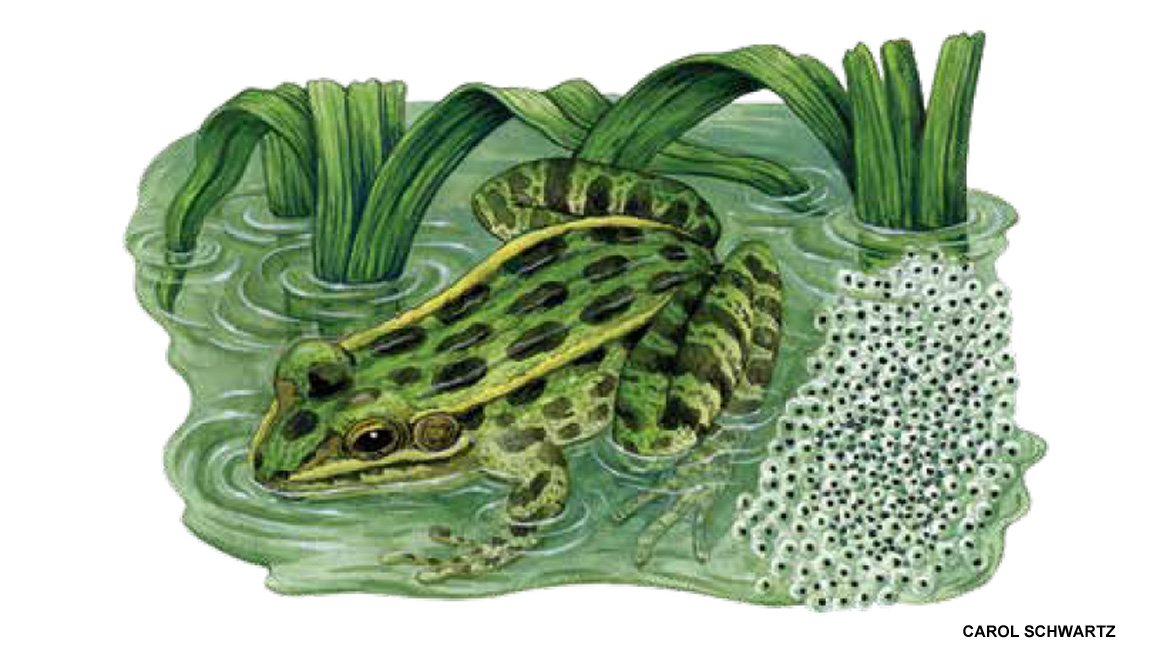
Go on an Egg Hunt
By Diane L. Burns; Art by Carol SchwartzSpring is in the air. And so is the sound of courting frogs. That means frog eggs will be coming soon to a wet spot near you. Why not go check out the action? Just use these helpful hints and hop to it!
by Diane L. Burns; art by Carol Schwartz
TIP 1: BE PREPARED
What kinds of eggs will you find? That depends on where you live. Different frogs live in different places. And each kind has its own breeding schedule. Visit your library or a local nature center to find out which frogs are in your area and when they’re breeding. Ask a librarian or naturalist to suggest a good guidebook that shows the frogs and describes their eggs.

TIP 2: SET UP A “STAKEOUT”
Frogs lay their eggs in water to keep them moist. Most frogs prefer water that’s calm and shallow. Depending on the kind of frog, that may include anything from a puddle to a pond, a marsh or a swamp, or even the edges of a big lake. Frogs usually stay away from deep or fast-flowing water.
TIP 3: USE YOUR EARS
Frog calls can help you pinpoint egg-laying places. And if you recognize the different calls, you can narrow down which eggs to look for. To hear recordings of some common frog calls, visit rangerrick.org/frog-calls online.

VIDEO: WATCH AND LISTEN TO AN AMERICAN TOAD!
TIP 4: KNOW WHAT TO LOOK FOR
Each frog egg starts out as a tiny dark spot surrounded by a thick layer of clear jelly-like stuff. The jelly acts as a kind of shell that protects the egg and the baby frog, or tadpole. As it grows, the tiny tadpole gets longer and curls into a “comma” shape. Most frogs’ eggs form clumps.
TIP 5: TAKE A CLOSER LOOK
Once you’ve found some eggs, see if your guidebook can help you identify them. Here are some things to notice: Are the eggs floating at the surface or under the water? Are they attached to plants or not? If they form a clump, is it small or large?

TIP 6: BE CAREFUL!
Wear the right clothes for the weather and the place. Be patient and move slowly and quietly in the animals’ homes. When you do find some eggs, it’s best to look but not disturb. If you touch them, do so very gently. And watch your step! Don’t be caught off guard by a patch of deep water or mud. Always make sure an adult goes with you or knows where you are.
TIP 7: KEEP IT UP
Don’t just forget about your eggs after you’ve found them. Go back to visit them every few days. How do the eggs change over time? Are any being gobbled up? If so, by what? How long do the eggs take to hatch? What are the tadpoles like? Think of other stuff to check on. “Hoppy” investigating!

WHAT ABOUT TOADS AND SALLIES?
Toads and salamanders also lay jelly-covered eggs in water. Most toad eggs form long strings. Many salamanders lay single eggs. But the spotted salamander lays eggs in a cluster that can look a lot like a clump of frog eggs.

















